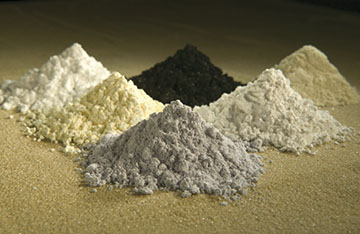China’s rare-earth metals
June 4, 2019 | Expert Insights

Background
Rare-earth elements encompass 17 chemicals in the periodic table. Despite their name, these elements are relatively plentiful in the Earth’s crust. However, because of their properties, these elements are typically distributed around the world. Rare-earth minerals are naturally occurring mixtures of several rare-earth elements. Commercially exploitable ore deposits are sparse, making them a valuable commodity.
The use of rare-earth elements has expanded since the first mineral was discovered in 1787. They are extensively used in low-carbon technologies and in the production of high-performance magnets, catalysts, alloys, glasses and electronics. High-performance magnets are used in applications such as electric motors, wind turbines, hard disks, portable electronics, microphones and speakers. As catalysts, these elements are used in petroleum refining and as diesel additives. Electronic applications of rare-earth elements include batteries, LCD screens, fibre optics and lasers. Other applications of these elements include fertilisers and water treatment.
Although China has only 36.7% of world reserves, in 2017, It accounted for 81% of the world’s rare-earth supply.
The US-China trade war has reached a stalemate with both sides unwilling to make concessions. Washington accuses China of stealing trade secrets and forcing American firms to hand over technology in exchange for access to the Chinese market. Both sides have applied tariffs on the other, severely impacting their economic performance.
Analysis
Chinese state-run newspapers have warned that China is ready to use rare-earths to strike back in a trade war with the US. The commentaries pointed to President Xi Jinping’s recent visit to a rare-earths plant to speculate that China might leverage its position as an exporter of these elements to the US in the ongoing trade war. The possibility of such a move has resulted in a significant increase to the share prices of rare-earth producers.
China is yet to explicitly state that it would restrict rare-earth sales to the United States. The National Development and Reform Commission (NDRC), which oversees economic policy shifts, made veiled references implying that China would use rare-earths as a trade weapon. The NDRC said that it would focus on domestic supply. Beijing had previously been taken to the World Trade Organisation (WTO) over short supply of rare-earth elements.
Since 2009, China has instituted various policies to reduce its export quota to conserve scarce resources and protect the environment. In 2010, Beijing forced smaller, independent rare-earth miners to merge into state-owned corporations or face closure. The measure was taken as smuggling of rare-earth minerals from China increased. Beijing sought to bring the resource under its control, understanding the importance of these elements to world trade. In 2011, China announced that it would half production in three of its eight major rare-earth mines. These mines were responsible for 40% of China’s rare-earth total output. The following year, the US, EU and Japan lodged a complaint at the WTO about the restrictions. China responded that it had instituted these policies over environmental concerns. In 2014, the WTO ruled that China had broken free-trade agreements, resulting in the country lifting all quotas from the export of rare-earth elements by 2015.
In 2010, following a maritime dispute with Japan, China blocked exports of rare-earth metals. This action, and the WTO ruling shows that China is willing to use its exporting power to make a political point. When exports to Japan were banned, it resulted in a spike in prices. This led to world powers seeking supplies elsewhere, eventually bringing down costs.
China currently exports relatively few rare-earth elements directly to the US. Products containing rare-earth metals go through a long production chain, mostly in Japan and China. The US still relies on China for about 80% of its rare-earth minerals for indigenous production needs. Consequently, the US excluded the elements from its list of prospective tariffs on the US$ 300 billion worth of Chinese goods to be targeted if another round of duties is to be imposed. President Trump signed an executive order in late 2017 to reduce America’s dependence on external sources of rare-earths, aimed at placating vulnerabilities to supply disruptions.
Assessment
Our assessment is that using rare-earths as a trade weapon would be difficult to implement in practice. We believe that the 2015 ruling by the WTO that found China in breach of international agreements by implementing quotas is likely to deter China from weaponising rare earth. It would be practically difficult for China to regulate trade in items that use rare-earth materials in its production. We feel that for China, any new restrictions would damage industrial supply chains developed after 2015, which are dependent on foreign customers in the US, Europe and Japan. We estimate that restrictions would strengthen notions that China is an unreliable source of supply. We believe that this would lead consumers to seek other sources of rare-earth supply, as was the case in 2010 and 2015. Simultaneously, we understand the strategic implications of restrictions on rare-earth supply; it would be damaging to production, as well as research and development efforts, in critical industries that use these elements.
India Watch
India produces 1,800 metric tons of rare-earth elements. However, the country holds over 35% of the world’s total sand mineral deposits. Should China choose to impose quotas on rare-earth exports, India sits poised to be able to make up for the shortfall. Significant rare earth minerals found in India include ilmenite, sillimanite, garnet, zircon, monazite and rutile, collectively called Beach Sand Minerals ( BSM ) In 2014, Indian Rare Earths and Toyota Tsusho Exploration agreed to explore the production of rare-earths via deep-sea mining.
Image Courtesy - Peggy Greb, US department of agriculture [Public domain]








Comments